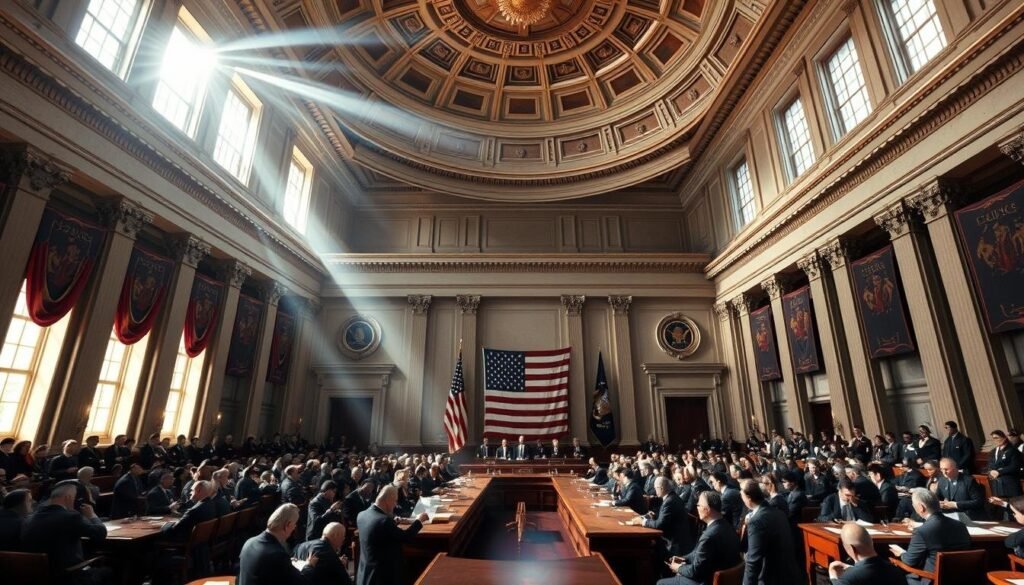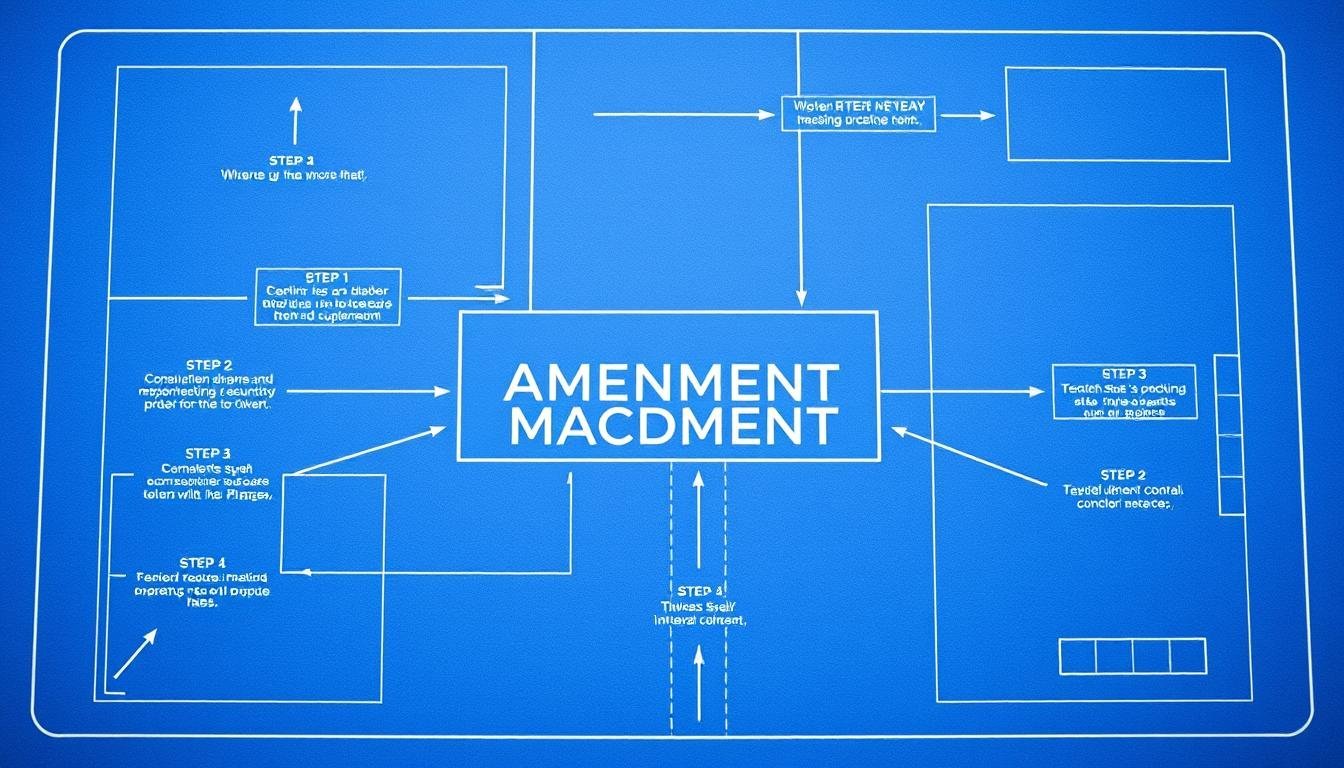Can a Sitting President Change the Constitution? Have you ever thought about if the current president can change the US Constitution? The process of changing the Constitution is complex. It involves different parts of the government.
The constitutional amendment process is made to be strict. This ensures any changes are well thought out and have broad support. When we look at the president’s role in changing the constitution, it’s important to know the limits.
In this article, we’ll dive into the details of the amendment process. We’ll see how it limits the president’s power. This will help clear up how much authority the president has in this area.
Contents
- 1 The Constitutional Amendment Process
- 2 Can a Sitting President Change the Constitution?
- 3 The Role of Congress in Constitutional Amendments
- 4 State-Driven Constitutional Changes
- 5 Historical Presidential Attempts to Influence Constitutional Amendments
- 6 Conclusion: Can a Sitting President Change the Constitution?
- 7 FAQ
- 7.1 Can a sitting president unilaterally change the US Constitution?
- 7.2 What is the process for amending the US Constitution?
- 7.3 What is the congressional proposal method for amending the Constitution?
- 7.4 What is the constitutional convention method for amending the Constitution?
- 7.5 How can a president influence the constitutional amendment process?
- 7.6 What role do states play in the constitutional amendment process?
- 7.7 Can a president’s influence guarantee the passage of a constitutional amendment?
- 7.8 What are some historical examples of presidential influence on constitutional amendments?
The Constitutional Amendment Process
Changing the US Constitution is a detailed process. It’s outlined in Article V of the Constitution. This ensures changes are well thought out.
The congressional proposal method is one way to suggest changes. It needs a two-thirds vote in both the House and Senate. This method has been used for all 27 amendments, showing it works well.
Constitutional Convention Method
The other way is the constitutional convention method. It lets two-thirds of state legislatures call for a convention. This gives states a say in proposing changes.
State Legislature Approval
Once a change is suggested, it must be approved by three-fourths of the states. State legislatures are key here. They can either agree or disagree with the proposed changes. This step makes sure changes are widely accepted.
State Ratifying Conventions
States can also hold ratifying conventions. This lets citizens directly influence the decision-making process. It adds another layer of control over changes.
In short, changing the Constitution involves many steps and players. It ensures changes are well thought out and supported by many. The mix of congressional and state actions helps protect the Constitution’s integrity.
- The congressional proposal method requires a two-thirds majority in both houses.
- The constitutional convention method involves a call from two-thirds of the state legislatures.
- Ratification requires approval from three-fourths of the states.
Can a Sitting President Change the Constitution?
Many wonder if a sitting president can change the Constitution alone. The answer depends on understanding the US system, especially the separation of powers. Each branch of government has its role.
The president has a lot of power, but not all. They can veto laws and lead the military. Yet, the Constitution also has checks to keep power balanced.
Separation of Powers Doctrine
The separation of powers is key in the US government. It spreads power among the legislative, executive, and judicial branches. This stops one branch from changing the Constitution alone. It keeps power balanced and protects the Constitution.
Bully Pulpit and Public Advocacy
A president can’t change the Constitution directly. But they can push for changes through public support. By shaping opinions and influencing laws, a president can affect the amendment process.
Working Through Political Allies
A president can also team up with Congress to propose amendments. Working together can build support for changes. But, Congress and states still have the final say.
In summary, a president is important in shaping laws and public opinion. But they can’t change the Constitution alone. Changing the Constitution needs agreement from many, ensuring careful and broad support.
The Role of Congress in Constitutional Amendments
Congress is key in shaping the U.S. Constitution’s future. The congressional proposal method is one way to propose changes.
Two-Thirds Majority Requirement
To propose an amendment, Congress needs a two-thirds majority in both the House and Senate. This ensures broad support for any change.
Joint Resolutions for Amendments
Congress uses joint resolutions to propose amendments. These must pass with a two-thirds majority in both houses. Then, they go to the states for ratification. This method makes proposing changes clear and efficient.
Cooperation between Congress and the president has led to big changes. For example, the 26th Amendment, which lowered the voting age to 18, was passed during such cooperation.
Political Party Dynamics
Political parties can make the amendment process tricky. The need for a two-thirds majority in Congress shows the importance of checks and balances. It ensures that changes have wide support.
| Aspect | Description | Significance |
|---|---|---|
| Two-Thirds Majority | Requirement for proposing amendments | Ensures broad support |
| Joint Resolutions | Method for proposing amendments | Streamlines the amendment process |
| Checks and Balances | System preventing any one branch from dominating | Protects the integrity of the amendment process |
State-Driven Constitutional Changes
States play a big role in changing the Constitution. While the federal government has a lot of power, states can also make changes. They do this through different ways.
The Never-Used Convention Method
States can call for a constitutional convention. This method has never been used to propose an amendment. But it’s still an option. A convention can be called if two-thirds of state legislatures agree.
Modern Calls for Conventions
In recent years, there have been calls for a constitutional convention. These calls show the ongoing debate about states’ role in shaping the Constitution.
Three-Fourths State Requirement
For any constitutional amendment to be ratified, it needs approval from three-fourths of the states. This ensures changes have wide support across the country.
Presidential Influence on State Decisions
The president can influence state decisions in many ways. This includes public persuasion and political pressure. But, the final decision is up to the states. This keeps the system of checks and balances in place.

| Method | Description | Requirement |
|---|---|---|
| Constitutional Convention | A gathering to propose amendments | Two-thirds of state legislatures |
| Ratification | Approval of proposed amendments | Three-fourths of the states |
Understanding these state-driven processes is key to knowing how the Constitution can change. The balance between federal and state powers is crucial for the amendment process.
Historical Presidential Attempts to Influence Constitutional Amendments
U.S. presidents have greatly influenced constitutional amendments throughout history. They have worked hard to change or add to the Constitution in many ways.
FDR and the 22nd Amendment
Franklin D. Roosevelt served four terms, leading to a big change. The 22nd Amendment, passed in 1951, limits a president to two terms. This was a direct response to FDR’s long time in office.
LBJ and the 25th Amendment
Lyndon B. Johnson’s presidency led to the 25th Amendment in 1967. It clarified who comes next in line for the presidency and how to fill a vice president’s spot. This was after President John F. Kennedy’s assassination.
Richard Nixon wanted to change how we elect the president to a direct vote. Though it didn’t pass, it showed the ongoing debate on our electoral system.
Reagan’s Balanced Budget Amendment
Ronald Reagan pushed for a balanced budget amendment. He wanted to control spending and lower the national debt. This was part of his conservative economic plan.
| President | Amendment/Proposal | Outcome |
|---|---|---|
| Franklin D. Roosevelt | 22nd Amendment | Ratified in 1951 |
| Lyndon B. Johnson | 25th Amendment | Ratified in 1967 |
| Richard Nixon | Direct Election Amendment | Not Ratified |
| Ronald Reagan | Balanced Budget Amendment | Not Ratified |
These examples show how hard it is to change the U.S. Constitution. Presidents have played key roles in these efforts.
Conclusion: Can a Sitting President Change the Constitution?
You now know that a sitting president can’t change the Constitution alone. The constitutional amendment process is tough, needing wide support for big changes. This keeps the Constitution safe from quick or bad changes.
The checks and balances system spreads power around. It stops one group from controlling everything. Congress and states are key in making and approving changes.
Understanding the amendment process shows how important the Constitution is. It helps you get involved in our democracy. This way, you can help shape America’s future.
See Also: Can the President Dissolve the Supreme Court?
FAQ
Can a sitting president unilaterally change the US Constitution?
No, a sitting president can’t change the Constitution alone. Changing the Constitution needs support from Congress and the states.
What is the process for amending the US Constitution?
The process is in Article V of the Constitution. It has two ways: Congress can propose, or a convention can be called. All must be ratified by three-fourths of the states.
What is the congressional proposal method for amending the Constitution?
Congress needs a two-thirds majority in both the House and Senate to propose an amendment.
What is the constitutional convention method for amending the Constitution?
This method needs a call from two-thirds of state legislatures to propose an amendment.
How can a president influence the constitutional amendment process?
A president can shape the process through public support, working with allies, and using their influence to sway public opinion.
What role do states play in the constitutional amendment process?
States are key, as three-fourths of them must ratify an amendment for it to pass.
Can a president’s influence guarantee the passage of a constitutional amendment?
No, a president’s influence alone can’t ensure an amendment passes. It needs support from Congress and the states.
What are some historical examples of presidential influence on constitutional amendments?
Examples include Franklin D. Roosevelt’s efforts for the 22nd Amendment and Lyndon B. Johnson’s role in the 25th Amendment. Other presidents like Nixon and Reagan also tried to influence changes.

Hi, I am Tatum Bradford from Washington. I have a background in political science and work as a senior revenue officer. I love learning about U.S. presidents and sharing interesting facts about political history.

